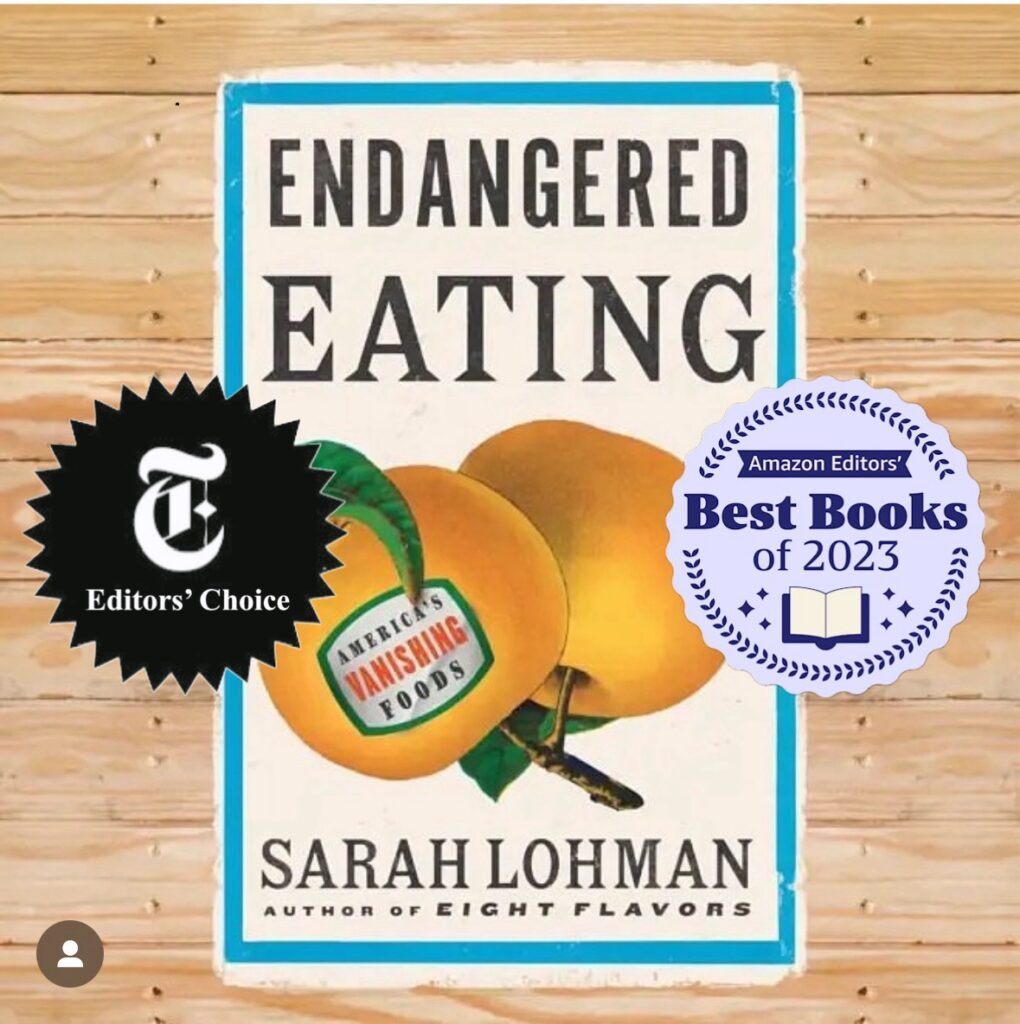Endangered Eating: America’s Vanishing Foods

ISBN 9781324004660
USA $28.95
CAN $38.95
Buy it now!! Amazon, or Bookshop.org
Press: Will Scarlet, wscarlett@wwnorton.com
A New York Times Book Review Editors’ Choice • A Food & Wine Best Book of 2023 • An Eater Best Food Book, Fall 2023 • Adam Gopnik’s Best Non-Fiction Food Book of the Year • Nach Waxman Prize for Food and Drink Scholarship Finalist • Ohioana Library Book Prize Non-Fiction and Reader’s Choice Winner
American food traditions are in danger of being lost. How do we save them?
Apples, a common New England crop, have been called the United States’ “most endangered food.” The iconic Texas Longhorn Cattle is categorized at “critical” risk for extinction. Unique date palms, found nowhere else on the planet, grow in California’s Coachella Valley —but the family farms that caretake them are shutting down.
Apples, cattle, dates—these are foods that carry significant cultural weight. But they’re
disappearing.
In Endangered Eating, culinary historian Sarah Lohman draws inspiration from the Ark of Taste, a list compiled by Slow Food International that catalogues important regional foods. Lohman travels the country learning about the distinct ingredients at risk of being lost. Readers travel with Lohman to Hawaii, as she walks alongside farmers to learn the stories behind heirloom sugar cane. In the Navajo Nation, she assists in the traditional butchering of a Navajo Churro ram. Lohman heads to the Upper Midwest to harvest wild rice; to the Pacific Northwest, to spend a day fishing on a traditional reefnet gear; to the Gulf Coast, to devour gumbo made thick and green with file powder; and to the Lowcountry of South Carolina, to taste America’s oldest peanut—long thought to be extinct. Lohman learns from those who love these rare ingredients: shepherds, fishers, and farmers; scientists, historians and activists. And she tries her own hand at raising these crops and preparing these dishes. Each chapter includes two recipes, so readers can be a part of saving these ingredients by purchasing and preparing them.
Animated by stories yet grounded in historical research, Endangered Eating gives readers
the tools to support community food organizations and producers that work to preserve local culinary traditions and rare, cherished foods—before it’s too late.
Praise for Endangered Eating
“[Endangered Eating] is as much a fascinating study of heirloom cider apples and Buckeye chickens as it is a commentary on the way politics, money and convenience have conspired against America’s culinary history. . . . The deep cultural and political history Lohman unearths is worth the ride.”
Kim Severson, New York Times Book Review
“Part travelogue, part history and part eulogy, [Lohman’s] book plumbs not just the American plate, but its soul
.”
Shreya Chattopadhyay, New York Times
“From Coachella Valley’s date gardens to heirloom cider apples in New York’s Hudson Valley to Choctaw filé powder in Louisiana, each stop Lohman makes is more interesting than the last. . . . But Endangered Eating isn’t just a foodie travelogue (with recipes sprinkled throughout). Lohman encourages people to follow her lead and learn more about their food’s origins.We can start by reading her intrepid book
“
Alexis Burling, Washington Post
“Lohman deftly combines history and people-forward accounts of her travels across the country to learn from food producers. The result is a thoughtful, compelling read about why these food traditions matter and are worth preserving.
“
Bettina Makalintal, Eater
“Endangered Eating is culinary historian Sarah Lohman’s surprising journey across the United States, visiting the vanishing futures of native peanuts, apples, Ojibwe wild rice, Hawaiian sugar cane.
“
Christopher Borrelli, Chicago Tribune
“Through eight first-person essays, Loman tracks down the farms, restaurants, growers, and fisherman that are part of the life cycle of ingredients like heirloom cider apples from the Hudson Valley, dates from California’s Coachella Valley, and even Navajo Churro sheep in the southwestern United States. In doing so, she illuminates how the delicate balance of agriculture, demand and production impact what is available and how we can protect heritage ingredients from being lost forever.
“
Korsha Wilson, Food & Wine
“Lohman wanders the nation armed with a notebook and a fork in search of disappearing foodstuffs. . . . [Endangered Eating] is about not just the foods but also the cultures that produced them, and Lohman does all of them justice.
“
Paul Rauber, Sierra magazine
“Sarah Lohman sheds light on the urgency of safeguarding Indigenous culinary customs through her tales of traversing America in search of endangered foods. In Endangered Eating she highlights the influence of colonization upon foodways, and also advocates for the localization of food systems and greater support for food producers and community organizations.
“
Liza Greene, Food Tank
“Enjoyable, entertaining, and meaningful. … A tasty sojourn through the landscape of America’s endangered foods, served with a scoop of energy and a dash of hope.”
– Kirkus
“In Endangered Eating Sarah Lohman gives readers a new and powerful lens through which to view the past, present, and future of food in America.”
-Dan Saladino, author of Eating to Extinction
“From sheep to wild rice, the foods we eat for both hedonistic exploits and sustenance have been going extinct; every time we breed a food to survive the rigors or worldwide transport we lose all its delicious attributes. Sarah Lohman shares compassionate stories about the importance of these foods and outlines what you can do personally to ensure their continued and delicious survival. Lohman carries Twain’s torch with her passion, love, and want to preserve these amazing foods for future generations.”
-Jeremy Umansky, chef and co-owner of Larder Delicatessen and Bakery
